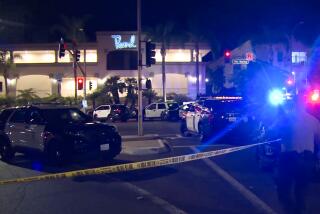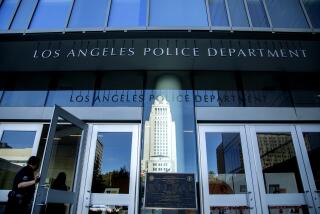Spain Arrests Terror Suspect, Citing Videos
- Share via
PARIS — Spanish police on Tuesday arrested a suspected member of an Al Qaeda cell in Madrid who allegedly took extensive videos of the World Trade Center, the Golden Gate Bridge and other potential targets during a terrorist reconnaissance mission in 1997. Alerted by the FBI, California officials beefed up security statewide.
The five videos, which were discovered recently, raised suspicions among Spanish police because the footage is much longer and more detailed than a typical tourist video. Comments that the suspect made during the recording led police to believe that he might have been a scout for terrorists.
A Bush administration official familiar with the operations of Al Qaeda said in Washington that the videos confirmed long-held fears that Osama bin Laden’s terrorist network had looked into targeting other landmarks besides the World Trade Center and the Pentagon.
“Sometimes he describes things, but at other moments he refers to someone else who will take a closer look at something,” said a Spanish law enforcement official who viewed the tapes. “He gives the impression that he is part of an operation. Some of the sites are tourist attractions, but the amount of time doesn’t make sense for a tourist--every conceivable angle, inside and out, close up and far away. It is definitely suspicious.”
The suspect, 37-year-old Ghasoub Abrash Ghalyoun, dedicated two full cassettes to the World Trade Center, filming exteriors and interiors, the official said. Abrash’s video of the Golden Gate Bridge paid particular attention to the support structure, according to investigators. The videos show other landmarks that have been the subject of terrorism alerts: the Brooklyn Bridge, Sears Tower in Chicago and the Statue of Liberty, as well as a still-unidentified New York airport, authorities said.
Abrash, a Syrian-born Spanish citizen, allegedly belonged to a Madrid terrorist cell that Spanish officials say played a support role in the Sept. 11 attacks. He traveled to the United States after sending his family on a trip to Syria, the law enforcement official said. Spanish police will work with U.S. agents to identify other men who appear in the videos, the official said.
Four months after he returned from the United States, Abrash allegedly met with a courier of Bin Laden in the Spanish Mediterranean coastal town of Castellon, a senior Spanish law enforcement official said, further bolstering the theory that Abrash was on a scouting mission for a possible attack.
Police believe that copies of the videos were handed over to the alleged courier, Mohammed Bahaiah, the senior official said.
“The suspicion is that videos were given to the courier and that the intended recipient could have been Bin Laden in Afghanistan,” the senior law enforcement official said. “Now the suspects have to be interrogated and explain the reason for the videos, all the question marks and dark areas of this matter.”
Bahaiah, also known as Abu Khaled, is a fugitive, according to authorities. Before Sept. 11, he lived in Turkey and traveled between Afghanistan and Europe as an emissary of Bin Laden, according to Spanish court documents.
The Bush administration official said advance scouting is part of a tried-and-true method Al Qaeda has used to conduct surveillance on a target years before an attack.
“They are very meticulous and careful in their planning,” said the U.S. official, who spoke on condition of anonymity. “The general premise of their operational planning cycle is two to three years from the identification of the target to the development of the operational terror cell and its training, the placement of the cell in the country and then the preparation for the attack, which can take months.”
The timing of the 1997 videos is consistent with the theory that Abrash was a scout for a plot that produced the Sept. 11 attacks, the Spanish police official said, adding that the amount of time it took to develop the Sept. 11 plot would be similar to the lead time for the bombings of the U.S. embassies in Kenya and Tanzania in 1998. Al Qaeda operatives first arrived in Kenya in 1993, he said.
It was not clear when police first viewed Abrash’s videos, which were among material seized in April when he was arrested and briefly detained. During that operation, police charged Mohammed Galeb Kalaje Zouaydi, his sometime business partner in real estate and construction ventures, with funneling hundreds of thousands of dollars to terrorists in Western Europe, the Middle East, the Balkans and elsewhere.
Besides being the cell’s alleged financier, Zouaydi is also the brother-in-law of the alleged courier, Bahaiah. On Tuesday, police arrested two other suspects, including Mohammed Khair, a Syrian businessman who lives in Castellon and is also accused of attending the meeting with the courier.
The case was launched in November when police dismantled what they believed to be a major cell in Madrid with ties to top Al Qaeda figures. Judge Baltasar Garzon accused a dozen suspects, most of them Syrian immigrants, of being accomplices in the Sept. 11 attacks. He based the charges on telephone numbers, travels, money transfers and other links to suspected Sept. 11 plotters.
Moreover, police are still investigating a suspected planning session held in Spain in July 2001 by alleged lead hijacker Mohamed Atta and Ramzi Binalshibh, an accused Hamburg-based accomplice.
In California, authorities throughout the state mobilized rapidly Tuesday in response to the perceived threat revealed in the videos. George Vinson, chief security advisor to Gov. Gray Davis, said he got word of the arrests in Spain and the contents of the videotapes Tuesday morning in calls from FBI officials.
The Highway Patrol, whose officers have been on high alert since Sept. 11, ordered security stepped up statewide, including extra aircraft patrols of the electricity grid, the California Aqueduct, reservoirs and nuclear power plants.
“There was no threat of anything imminent, but we are taking this thing seriously,” said CHP Commissioner D.O. “Spike” Helmick.
He refused to say how many extra officers were mobilized but said the force was “significant.” In addition to surveillance from nearly three dozen airplanes, more officers were added to guard the Golden Gate and other key bridges, including the Bay Bridge, the Vincent Thomas Memorial Bridge in San Pedro and the Coronado Bridge in San Diego.
Times staff writers Josh Meyer in Washington and Carl Ingram in Sacramento contributed to this report.
More to Read
Sign up for Essential California
The most important California stories and recommendations in your inbox every morning.
You may occasionally receive promotional content from the Los Angeles Times.










